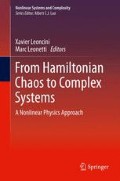Abstract
We review some properties of the “belief propagation” algorithm, a distributed iterative map used to perform Bayesian inference and present some recent work where this algorithm serves as a starting point to encode observation data into a probabilistic model and to process large-scale information in real time. A natural approach is based on the linear response theory and various recent instantiations are presented. We will focus on the particular situation where the data have many different statistical components, representing a variety of independent patterns. As an application, the problem of reconstructing and predicting traffic states based on floating car data is then discussed.
Access this chapter
Tax calculation will be finalised at checkout
Purchases are for personal use only
Notes
- 1.
Potentially any arbitrary mapping ϕ(x) could be considered to perform the moment matching.
References
D.J. Amit, H. Gutfreund, H. Sompolinsky, Statistical mechanics of neural networks near saturation. Ann. Phys. 173(1), 30–67 (1987)
H. Chau Nguyen, J. Berg, Bethe-peierls approximation and the inverse ising model. ArXiv e-prints, 1112.3501 (2011)
S.Cocco, R. Monasson, Adaptive cluster expansion for the inverse Ising problem: convergence, algorithm and tests. arXiv:1110.5416, 2011
S. Cocco, R. Monasson, V. Sessak, High-dimensional inference with the generalized hopfield model: Principal component analysis and corrections. Phys. Rev. E 83, 051123 (2011)
A. de Palma, F. Marchal, Real cases applications of the fully dynamic METROPOLIS tool-box: an advocacy for large-scale mesoscopic transportation systems. Networks Spatial Econ. 2(4), 347–369 (2002)
B. Frey, D. Dueck, Clustering by passing messages between data points. Science 315, 972–976 (2007)
C. Furtlehner, Y. Han, J.-M. Lasgouttes, V. Martin, F. Marchal, F. Moutarde, Spatial and temporal analysis of traffic states on large scale networks. In Intelligent Transportation Systems (ITSC), 2010 13th International IEEE Conference on, pp. 1215 –1220, 2010
C. Furtlehner, J.-M. Lasgouttes, A. Auger, Learning multiple belief propagation fixed points for real time inference. Physica A: Stat. Mech. Appl. 389(1), 149–163 (2010)
C. Furtlehner, J.-M. Lasgouttes, A. de La Fortelle, A belief propagation approach to traffic prediction using probe vehicles. In Proceedings IEEE 10th Intelligent Conference Intelligent Transport System, pp. 1022–1027, 2007
A. Georges, J. Yedidia, How to expand around mean-field theory using high-temperature expansions. J. Phys. A: Math. Gen. 24(9), 2173 (1991).
Y. Han, F. Moutarde, Analysis of Network-level Traffic States using Locality Preservative Non-negative Matrix Factorization. In Proceedings of ITSC, 2011
N. Hansen, A. Ostermeier, Completely derandomized self-adaptation in evolution strategies. Evol. Comput. 9(2), 159–195 (2001)
T. Heskes, On the uniqueness of loopy belief propagation fixed points. Neural Comput. 16, 2379–2413 (2004)
J.J. Hopfield, Neural network and physical systems with emergent collective computational abilities. Proc. Natl. Acad. Sci. USA 79, 2554–2558 (1982)
E.T. Jaynes, Probability Theory: The Logic of Science (Vol 1) (Cambridge University Press, Cambridge, 2003)
Y. Kabashima, D. Saad, Belief propagation vs. tap for decoding corrupted messages. Europhys. Lett. 44, 668 (1998)
H. Kappen, F. Rodrguez, Efficient learning in boltzmann machines using linear response theory. Neural Comput. 10(5), 1137–1156 (1998)
F.R. Kschischang, B.J. Frey, H.A. Loeliger, Factor graphs and the sum-product algorithm. IEEE Trans. Inf. Th. 47(2), 498–519 (2001)
V. Martin, Modélisation probabiliste et inférence par l’algorithme Belief Propagation, Thèse de doctorat, Ecole des Mines de Paris, 2013
M. Mezard, T. Mora, Constraint satisfaction problems and neural networks: A statistical physics perspective. J. Physiology-Paris 103(1–2), 107–113 (2009)
M. Mézard, G. Parisi, M. Virasoro, Spin Glass Theory and Beyond (World Scientific, Singapore, 1987)
M. Mézard, R. Zecchina, The random K-satisfiability problem: from an analytic solution to an efficient algorithm. Phys. Rev. E 66, 56126 (2002)
T. Minka, Expectation propagation for approximate bayesian inference. In Proceedings UAI, pp. 362–369, 2001
J.M. Mooij, H.J. Kappen, On the properties of the Bethe approximation and loopy belief propagation on binary network. J. Stat. Mech. P11012 (2005)
J. Pearl, Probabilistic Reasoning in Intelligent Systems: Network of Plausible Inference (Morgan Kaufmann, San Mateo, 1988)
T. Plefka, Convergence condition of the tap equation for the infinite-ranged ising spin glass model. J. Phys. A: Math. Gen. 15(6), (1971, 1982),
PUMAS project, (2010–2013). http://pumas.inria.fr/public/document
TRAVESTI project, (2009–2012). http://travesti.gforge.inria.fr/
M.J. Wainwright, Stochastic processes on graphs with cycles: geometric and variational approaches. PhD thesis, MIT, 2002
Y. Watanabe, K. Fukumizu, Graph zeta function in the bethe free energy and loopy belief propagation. In Advances in Neural Information Processing Systems, vol. 22, pp. 2017–202, 2009
Y. Weiss, W.T. Freeman, Correctness of belief propagation in gaussian graphical models of arbitrary topology. Neural Comput. 13(10), 2173–2200 (2001)
M. Welling, Y.W. Teh, Approximate inference in boltzmann machines. Artif. Intell. 143(1), 19–50 (2003)
M. Yasuda, K. Tanaka, Approximate learning algorithm in boltzmann machines. Neural Comput. 21, 3130–3178 (2009)
J.S. Yedidia, W.T. Freeman, Y. Weiss, Generalized belief propagation. Adv. Neural Inform. Process. Syst. 13, 689–695 (2001)
Acknowledgment
This gives me the occasion to express my warm thanks to my colleagues Victorin Martin and Jean-Marc Lasgouttes with whom it is a pleasure to collaborate on the main subjects discussed in this review. I am also grateful to Anne Auger, Yufei Han, Fabrice Marchal and Fabien Moutarde, for many aspects mentioned in this work concerning ongoing projects. This work was supported by the grant ANR-08-SYSC-017 from the French National Research Agency.
Author information
Authors and Affiliations
Corresponding author
Editor information
Editors and Affiliations
Rights and permissions
Copyright information
© 2013 Springer Science+Business Media New York
About this chapter
Cite this chapter
Furtlehner, C. (2013). An Ising Model for Road Traffic Inference. In: Leoncini, X., Leonetti, M. (eds) From Hamiltonian Chaos to Complex Systems. Nonlinear Systems and Complexity, vol 5. Springer, New York, NY. https://doi.org/10.1007/978-1-4614-6962-9_10
Download citation
DOI: https://doi.org/10.1007/978-1-4614-6962-9_10
Published:
Publisher Name: Springer, New York, NY
Print ISBN: 978-1-4614-6961-2
Online ISBN: 978-1-4614-6962-9
eBook Packages: EngineeringEngineering (R0)

